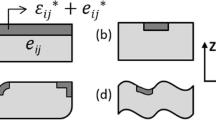Abstract
For critical load bearing structures, it is often necessary to experimentally determine the load distribution on the structure so that accurate finite element models can be developed for stress and fatigue life predictions. An inverse problem approach is presented here for computing or calibrating the loads and boundary conditions acting on a structure. This enables the creation of more accurate finite element models, especially for structures that have complicated load distribution and compliant boundary conditions. The method presented here involves minimizing the least square error between the strains computed using the finite element model and the strains and displacements obtained experimentally. The nodal loads and the compliance at fixed boundaries are treated as the variables in the optimization problem. The compliance is modeled as springs attached at the nodes that are on the boundary where the structure is restrained. The method is verified by computing the loads and boundary conditions when displacements, maximum shear strain or both are available at large number of points on the surface of the structure. The experimental data set was generated using the luminescent photoelastic coating (LPC) technique.
Similar content being viewed by others
References
Fu G, Moosa AG (2002) An optical approach to structural displacement measurement and its application. J Eng Mech 128(5):511–520.
Chock JMK, Kapania RK (2003) Load updating for finite element models. AIAA J 41(9):1667–1673.
Reich GW, Park KC (2001) A theory for strain based structural system identification. J Appl Mech, ASME 68(7):521–527.
Sanayei M, Saletnik MJ (1996) Parameter estimation of structures from static strain measurements. I. Formulation. J Struct Eng, ASCE 122(5):555–562.
Shkarayev S, Krashantisa R, Tessler A (2001) An inverse interpolation method utilizing in-flight strain measurements for determining loads and structural response of aerospace vehicles” 3rd International Workshop on Structural Health Monitoring, September 12–14, Stanford, California.
Liu T, Barrows DA, Burner AW, Rhew RD (2001) Determining aerodynamic loads based on optical deformation measurements. AIAA J 40(6):1105–1112.
Cao X, Sugiyama Y, Mitsui Y (1998) Application of artificial neural networks to load identification. Comput Struct 69:63–78.
Cardenas-Garcia JF, Ekwaro-Osire S, Berg JM (2001) Solution to the Moiré hole method problem. Mech Res Commun 28(1):13–32.
Cardenas-Garcia JF (2000) Determination of the elastic constants using Moiré. Mech Res Commun 27(1):69–77.
Wang Z, Cardenas-Garcia JF, Han B (2005) Inverse method to determine elastic constants using a circular disc and Moiré interferometry. Exp Mech 45(1):27–34.
Cardenas-Garcia JF, Shabana YM (2005) An inverse problem finite-element-method-based approach to the hole drilling method in photoelasticity. Proceedings of the 2005 SEM Conference and Exhibition on Experimental and Applied Mechanics, Paper No. 33.
Cardenas-Garcia JF, Ekwaro-Osire S, Berg JM, Wilson WH (2005) Non-linear least-squares solution to the Moiré hole method problem in orthotropic materials. Part I. Residual stresses. Exp Mech 45(4):301–313.
Cardenas-Garcia JF, Ekwaro-Osire S, Berg JM, Wilson WH (2005) Non-linear Least-squares solution to the Moiré hole method problem in orthotropic materials. Part II. Material elastic constants. Exp Mech 45(4):314–324.
Cho S, Cardenas-Garcia JF, Chasiotis I (2005) Measurement of nanodisplacements and elastic properties of MEMS via the microscopic hole method. Sens Actuators A 120:163–171.
Avril S, Grediac M, Pierron F (2004) Sensitivity of the virtual fields method to noisy data. Comput Mech 34:439–452.
Grediac M (2004) The use of full-field measurement methods in composite material characterization: interest and limitations. Compos: Part A 35:751–761.
Grediac M, Pierron F (2004) Numerical issues in the virtual fields method. Int J Numer Methods Eng 59:1287–1312.
Bonnet M, Constantinescu A (2005) Inverse problems in elasticity. Inverse Probl 21:R1–R51.
Hubner JP, Ifju PG, Schanze KS, Liu Y, Chen L, El-Ratal W (2004) Luminescent photoelastic coatings. Exp Mech 44(4):416–424.
Hubner J, Chen L, Liu Y, Schanze K, Nicolosi J, Ifju P, El-Ratal W (2005) Characterization of a new luminescent photoelastic coating. Exp Mech 45(2):137–143.
Bertsekas DP (1999) Nonlinear Programming, Second Edition. Athena Scientific.
Author information
Authors and Affiliations
Corresponding author
Rights and permissions
About this article
Cite this article
Padmanabhan, S., Hubner, J.P., Kumar, A.V. et al. Load and Boundary Condition Calibration Using Full-field Strain Measurement. Exp Mech 46, 569–578 (2006). https://doi.org/10.1007/s11340-006-8708-2
Received:
Accepted:
Published:
Issue Date:
DOI: https://doi.org/10.1007/s11340-006-8708-2




